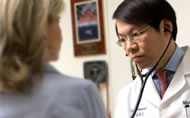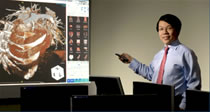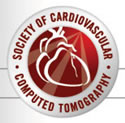Q: What were the results of the CorE
64 trial? How accurate is Multislice CT Angiography (CTA)
as compared with standard angiography performed in the catheterization
lab?
Dr.
Poon: I think the study was well-done. It showed that, as a test
to rule out the presence of significant
coronary
disease, CTA is capable of doing a rather good job. But at
this moment it’s still not the test that you would use
to compete with diagnostic angiography for accuracy. I think
that’s the conclusion that we can draw from the CorE
64 data.
Q: During the panel discussion after
the CorE 64 presentation at last week's AHA, Dr.
Michael Lauer, who left the Cleveland Clinic this year for
the National Heart, Lung
and Blood Institute, voiced strong objections to
the widespread use of Cardiac CT. But don't the results of
the CorE 64 trial basically reinforce previous studies,
for example the CATSCAN study from Cleveland
Clinic.
Dr. Poon: CTA
is a great test to rule out the presence of disease. Its negative
predictive value
is very high. That basically
has always been what the data’s been showing. I don’t
understand why Dr. Lauer was being so negative. The fact is
that it cannot completely replace diagnostic cath. Yet he went
ballistic. And I said, “Whoa!” He wanted to put
a two year moratorium on this technology, which I think will
be detrimental to patients who could benefit from this test.
Nobody in my view is thinking that
CT will replace diagnostic cath.
In fact, that was the reason Dr. Lauer was objecting to CT,
he said “You
see -- the CorE 64 shows that this test is nowhere near the
accuracy of a diagnostic cath.” We never claimed that
CT is going to replace diagnostic cath. We said that the accuracy
of CT is very good when it comes to ruling out the presence
of disease. We never said that CT is as accurate as diagnostic
cath. So, you have to look at the two ends of the spectrum.
When you look at the disease process, it goes from no disease
to a lot of disease. So, CT is focusing on one end, which is
the “no disease” end. Diagnostic cath is focused
on the other end, which is “how bad is your disease.” So,
CTs job is to rule out the presence of disease on the low-to-intermediate
risk group.

Dr.
Poon with a patient |
|
Q: So if patient
selection is important, who are the patients that can
best benefit from CTA?
Dr. Poon: Again, we are not advocating doing this
on everybody. We are not advocating doing CTA on a patient
who is asymptomatic. We have very clear guidelines, based
on the published Appropriateness
Criteria. I was on the writing
committee and we specifically stated that this test is indicated
in patients with symptoms suggestive of the presence coronary
artery disease, in lieu of doing invasive angiography, which
is a test that can be 30-40% negative for coronary artery
disease. |
Just look at the National Cardiovascular
Data Registry (NCDR) for the the percentage of unnecessary
caths, meaning that after
the diagnostic cath, the operator decided that there is no
need for further intervention. In other words the test could
have been avoided. And it’s close to 40%. So the strength
of cardiac CT is to help this group of patients to have a test
which is non-invasive, and can rule out the presence of significant
coronary disease, so they don’t have to go to the cath
lab and subject themselves to an invasive procedure which carries
a percentage of potential complications, both mortalities and
morbidities.
Q: What are those percentages? Mortality
is very low, but we’ve heard 3-4% quoted for vascular
Dr. Poon: 3-4% is a pretty conservative
estimate. As for some of the groin complications, they may
be minor, but you wouldn’t
want to be the one who has it. And there is no long-term follow
up on the impact of these complications on the individual.
Q: Yes, we have a number of patients
writing
into our Forums two or three months after
a cath with problems in their leg
that started right after
the cath.
Dr. Poon: Exactly.
Q: What about the radiation exposure
with CT compared to standard catheterization. The popular
press quoted
a figure of 10 times greater. That’s not true is it?
Dr.
Poon: No, that’s not true. There are very widely
published data on that. The number we quote is from an article
published by Cynthia McCullough
of the Mayo Clinic, and based on her study, the amount of radiation
that you get
from a 64 slice CT is somewhere between 7-14 millisieverts
(mSv) and the conventional diagnostic cath can go as high as
5-10
mSv.
So
it’s absolutely
not a ten-times more procedure in terms of radiation exposure.
And furthermore there are many ways that you can lower the
dose.
The whole issue about radiation risk is a very hypothetical
one, because walking around in NYC over the course of a year,
you randomly get an amount of radiation that is about 2-3 mSv.
Just from the sunlight. So one 64 slice CT will be getting
the amount of radiation you would normally be exposed to in
3 years. So do people after three years of existence automatically
get cancer? No. So people really need to be educated about
the risks.
You also have to look at the
alternative modality that nobody questions about the radiation
exposure: the nuclear stress test, which is the
most common diagnostic test for patients with chest pain. The
total number
of nuclear stress exams is 8 million a year. Yet the radiation
exposure of nuclear stress test, based on Dr. McCullough’s
estimate, is equal if not higher than 64 slice CT.
Q: Is that why some cardiologists
think that cardiac CT Angiography will impact the nuclear
stress
test
more than it will standard angiography.
What is the role of a nuclear stress test, and does CTA really
answer those questions?
Poon: That's a very good question, because one of the problems
with a high percentage of patients going to the cath lab and
then finding out that they don't have disease is that the nuclear
stress test carries a very high false positive rate. If you
look at the eight million nuclear stress tests done a year,
because of the sensitivity and specificity, it's only somewhere
between seventy-five to eighty-five percent, even in good hands.
Therefore, nuclear generates close to twenty-five or thirty-five
percent of false positives.
Q: That seems like a lot.
Poon: That's a lot, and these patients go on to the
cath lab and to potentially getting complications from the tests
--
and the number, as we just talked about, is between 3-4% that
have vascular complications. And I'm sure that number
is underreported. So, the role of CT in many expert eyes is
that maybe, before we do nuclear, we should do a CT first.
And if the CT is normal, then you don't need anything. And
if the CT is abnormal, then you may want to do a nuclear at
that point to find out whether it's significant or not. So
you basically help nuclear to focus on what it's good at by
not sending everybody to nuclear, because nuclear, if you do
that, will carry a very high false positive rate.
Q:
As well as significant radiation dose.
Poon: That's right, and the radiation from nuclear
is no less than CT. In fact, probably a lot more, depending
on the way
that you do the test. Whether you use sestamibi or whether
you use thallium. The dose from thallium is two or three
times higher than CT, and no one talks about that.
Q:
The other question about CT, and this is something alluded
to in someof the press coverage, is that there's a
bit of a turf battle going on
between
the cardiologists who do invasive angiography in the cath lab
and the radiologists who do the CT scanning-- except isn't
the whole point of your organization, the Society for Cardiovascular
CT (SCCT), that cardiologists are starting to do the 64-slice
CT?
| 
Dr.
Poon conducting a
training session
|
|
Poon: Yes, I think
the SCCT is an organization that represents both radiologists
and cardiologists. We are here to promote a collaboration
between the two sub-specialties.
And, as long as you
put in the time and effort to learn, we don't think
one
sub-specialty is superior over any other. You know,
I think we need to stress quality, not what you're
card-carrying
members of, and I think that is our emphasis, that
we're here to promote high quality cardiac CT study. |
And we put out a
very good training program, the CTA Academy - Practicum.
This is a joint collaboration between the American College
of Cardiology and the Society for Cardiovascular CT. We are
now running regular training programs at the Heart House
in Washington, D.C. to train people who are interested in
seeking Level 2 certification in cardiac CT.
| So our society's
emphasis is not turf war,
but collaboration. We have eminent radiologists on our board,
like Jack Ziffer, Norbert Wilke and Larry Boxt, and we work
on multiple task forces together to promote
cross-pollination,
and maintenance of high quality study and training programs.
We promote a lot of
research, and collaboration between the American College
of Cardiology
(ACC) and the American College of Radiology (ACR). In
fact a lot of the advocacy efforts that we are working on
are joint
efforts between ACC and ACR. I think that's the most effective
way of getting the politicians, and the vendors and the health
care providers to listen to us, that we are working together. |
|
 |
Q: Do you see
then that invasive X-ray catheterization and CT are not really
at odds with each other?
Poon: No, I don't think so. In fact, I've worked with
the Cardiology Research Foundation (CRF) and we are looking into
future collaboration between CT and the cath lab. Perhaps CT
can provide additional insight to the invasive cardiologists
on what lesion would require what kind of intervention. And
also to help them perhaps cut down the amount of radiation
time required in the cath lab, if we can provide them with
some of the computer-aided diagnostic techniques using CT image.
To give you an example, the CT can tell you exactly at which
orientation the coronary artery is coming out of the aorta,
so that automatically can help you to select the catheter required
to do the test, so you don't have to guess.
Q: So here's an example where CT can actually reduce the radiation
dose.
Poon: Absolutely, absolutely! So you don't have to fish around
to find the right catheter.
Q: At the TCT I saw that Jeff Moses used the Stereotaxis system,
where CT and conventional angiography are combined, in order
to open a Chronic Total Occlusion (CTO) which was quite impressive.
Poon: This is exactly what I'm talking about. I see
mutual benefits from working together, and new technology provides
you with new ways of looking at things. I remember when I was
a fellow, sometimes I had no idea what catheter to use -- sometimes
you'd
go through ten to find one. CT can tell you exactly which one
you need. So, I think it's an important technology to be recognized,
that this is not a new layer that we add to the diagnostic
algorithm. We are providing a new approach that potentially
can cut down costs, cut down the risks involved, and also save
the operator in the cath lab a lot of unnecessary radiation.
| This interview was conducted
in November 2007 by Burt Cohen of Angioplasty.Org. |
|
